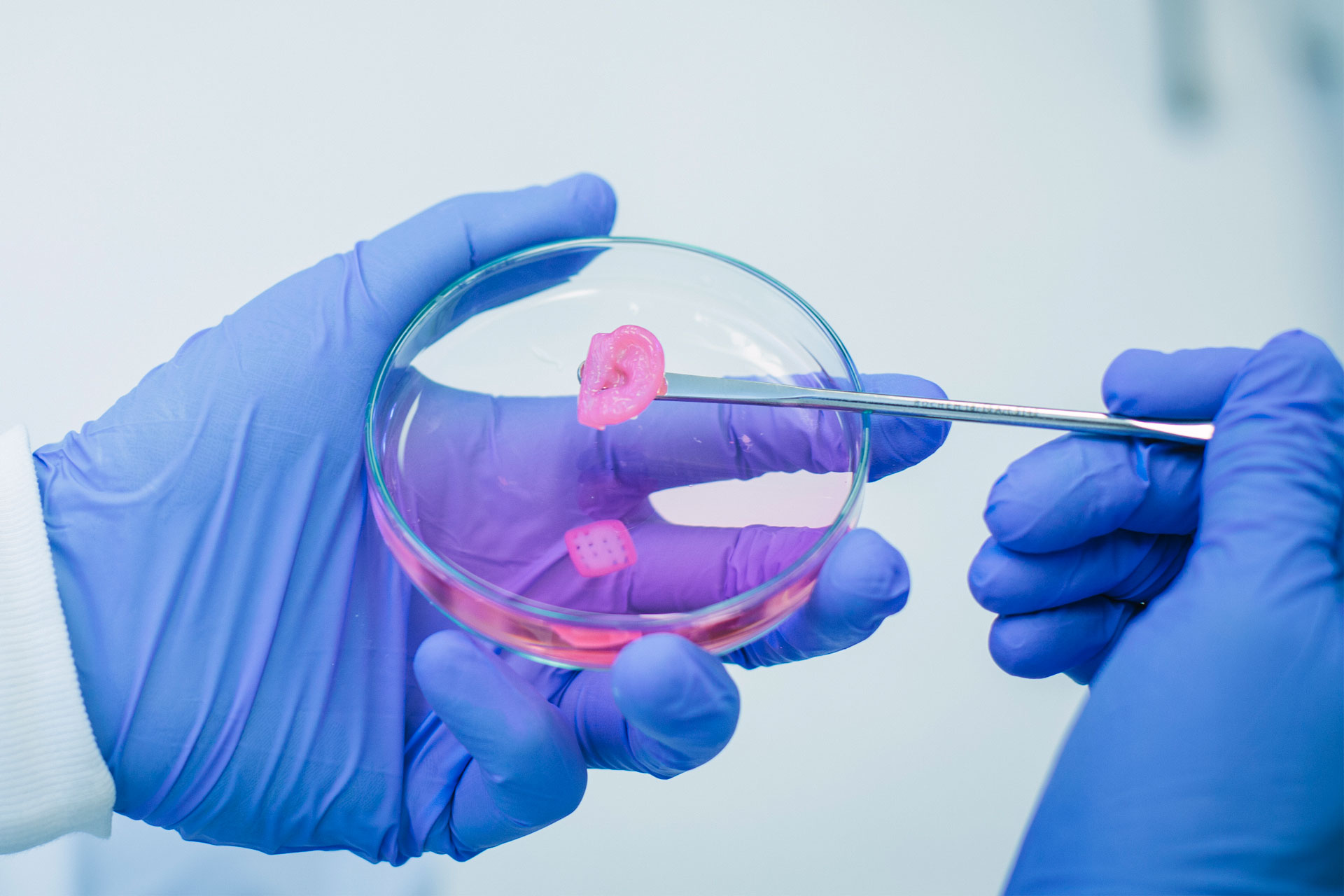Bioprinting – explained simply!
Bioprinting is a technology where bioinks and biomaterials, mixed with cells, are 3D printed, often to construct living tissue models. The process of 3D bioprinting follows that of additive manufacturing, where a digital file acts as a blueprint to print an object layer-by-layer. Although bioprinting is a new technology, it has already shown huge benefits within the applications of regenerative and personalized medicine, tissue engineering, drug discovery and cosmetics.

How bioprinting works
3D bioprinting, built on the foundations of 3D printing, comes with a lot of freedom. Bioprinting’s freedom makes it an excellent tool in biological research applications, which means there isn’t one easy method which can explain how bioprinting works. The technology is constantly evolving and shifting, and the steps in the workflow will change over time. Today, we view the workflow in three distinct stages:
-
Pre-bioprinting:
This step first involves creating a digital file, or 3D model, for the printers to read. The application determines whether the 3D model is built from scratch, based on a scan, if it is as simple as a droplet, or something else. Some bioprinting software, like our DNA Studio, gives researchers the ability to design simple 3D geometries directly on the printer. Other bioprinters will require the use of external software and 3D modeling, or CAD, skills.
In this step, you also prepare the printing material. For cellular applications with cells embedded into the bioink, researchers will need to prepare their cells and mix them with the bioink. Note that some cellular applications require the researcher to seed the cells onto the printed construct in step 3. If the application is acellular, the researcher will only need to prepare their material appropriately. -
Bioprinting:
For extrusion-based bioprinting, researchers will load the cell-laden bioink into cartridges and load these into one or multiple printheads. The researcher sets the parameters on the printer, and starts the print. The bioink will be extruded into the desired shape. For light-based bioprinting, researchers will put a photosensitive bioink, such as a photoink, in a vat. The structure is then built by projecting a patterned light onto the bioink, which will form the desired shape by moving the print arm. Developing different types of 3D tissue models requires researchers to use different types of cells, bioinks and equipment. -
Post-bioprinting:
Most 3D bioprinted structures need to be crosslinked to become fully stable. Crosslinking is usually done by treating the construct with either ionic solution or UV light. The construct’s composition helps researchers determine what kind of crosslinking to use. Typically, you will now proceed with covering the 3D tissue models with the relevant cell medium, and place it in an incubator for cultivation.
Bioprinting applications
Today’s bioprinting technologies are still new to many researchers. As scientists in the field continue making discoveries, 3D bioprinting can have a huge impact on a range of application areas. Some of these applications, we discuss more in-depth below:
Drug development done ethically, fast and cost-effective
Many studies today rely on living subjects, commonly animals. This is an inconvenient and expensive method for academic and commercial organizations alike.
Bioprinted tissue models can be used in the early stages of drug development to provide a more ethical and cost-effective solution. Using bioprinted tissue can help researchers determine a drug candidate’s efficacy sooner, which saves both money and time.
Bioprinted artificial organs
Patients have to wait years to get the help they needed yesterday, due to the length of the organ donation list. The ability to print 3D organs would help clinicians keep up with patients and, ideally, eliminate the wait list entirely.
While this solution is far down the line, it is one of the most impactful possibilities for bioprinting. You can read more in our blog: 3D Printed organs: How, Why and When
Wound healing through bioprinted constructs
Wound healing is one of the premiere research topics for current bioprinting researchers. And no wonder, as bioprinting has a huge potential in speeding up wound-healing in various tissues. For example, skin grafts, bone bandages and patches that correspond to other native tissues, such as lungs. It is an exciting application area, and one where we hope to see make an impact in the world in the foreseeable future.
Spheroids and 3D printing
Another important reason and application for 3D printing with a bioprinter is the inherent compatibility with spheroids. Spheroids are sphere-like cell aggregates that form during cell proliferation. Bioinks and printed constructs tailored for spheroids help create relevant tissue models. Bioinks have the ability to mimic a cell’s ECM, which allows cells to interact with their environment. You can learn more about spheroids and their applications in our article: What is a spheroid? And why they are important
3D bioprinting is still a new, developing technology
3D bioprinting is the name for both the technology and process in which bioinks are 3D printed, often to form living tissue-like constructs using cells. Researchers can closely mimic the biological environments they want to study or recreate by using this technology. The tissue-like construct can then be studied in their desired application. This to enable the study of this tissue in a given application. This biomimicry is important for everything from more efficient drug discovery to the future potential of full-size 3D printed organs, and other application areas.
Overall, 3D bioprinting is still a new and emerging field. While biocompatible 3D printing was invented in the early 1980s, cell-embedded 3D bioprinting was invented in 2003 by Thomas Boland. And since then, we’ve come a long way in a short time! As more researchers get access to the latest bioprinting technology, the innovating will only accelerate and what discoveries the future holds is unknown.
One thing is for sure: we can’t wait to see what CELLINK’s collaborators are discovering in the coming few years, as we continue to develop our technology to help researchers create the future of health.





